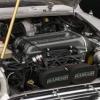Looking at a fletcher radiator, I need to run a temp sensor.
Does anyone have an experience of using a fletcher radiator with a temp sensor.
It has a drain plug, can this be used for the standard spi/mpi sensor?


Posted 16 December 2017 - 06:19 PM
Looking at a fletcher radiator, I need to run a temp sensor.
Does anyone have an experience of using a fletcher radiator with a temp sensor.
It has a drain plug, can this be used for the standard spi/mpi sensor?

Posted 16 December 2017 - 08:33 PM
Posted 16 December 2017 - 09:10 PM
Sure that is an option.
I think the drain on the fletcher might be m14. Car builder solutions have many m14 temp switches.
On at 87ºC, Off at 82ºC or On at 97ºC, Off at 85ºC
The minispares one I current use is on @ 92° and off @ 82°.
Posted 16 December 2017 - 10:26 PM
Posted 16 December 2017 - 10:37 PM
I don't like manual switches as it's easy to miss the temp rising and cook it
You want your fan switch in the upper hose
Not at the bottom of the rad
Pretty sure cbs sell a hose adapter for a fan switch
Merv
Posted 16 December 2017 - 10:52 PM
I use a Fletcher rad with a 87/82 fan switch, works well. However my rad is front mounted so this may make a difference.
Posted 16 December 2017 - 11:51 PM
I don't like manual switches as it's easy to miss the temp rising and cook it
You want your fan switch in the upper hose
Not at the bottom of the rad
Pretty sure cbs sell a hose adapter for a fan switch
Merv
I do have the temp sense for the ECU in the top hose, that also steers the gauge.
Posted 17 December 2017 - 08:53 AM
You could fit a thermocouple switch with a manual switch as an override.
Posted 17 December 2017 - 10:03 AM
You could fit a thermocouple switch with a manual switch as an override.
Posted 17 December 2017 - 01:28 PM
Looking at these Fletcher radiators, They look identical (except for the fletcher logo) to the Chinese alloy radiators.
I thought they were better quality. Seems they are the same. I will just go for a Chinese alloy radiator for an SPI.
I have one of those already, but I managed to trim the inlet pipe too much. ![]()
Posted 17 December 2017 - 01:36 PM
Posted 18 December 2017 - 03:27 AM
I think the temp sender needs to be at the top of the radiator as water get lighter as it gets hotter. May be the top hose would be a good option as Craig suggested.
Posted 20 December 2017 - 01:15 PM
I think the temp sender needs to be at the top of the radiator as water get lighter as it gets hotter. May be the top hose would be a good option as Craig suggested.
I should have stated temperature Switch, not sensor. My mistake
Posted 20 December 2017 - 04:30 PM
I think the temp sender needs to be at the top of the radiator as water get lighter as it gets hotter. May be the top hose would be a good option as Craig suggested.
I should have stated temperature Switch, not sensor. My mistake
Obviously, the objective of the fan is to reduce the coolant temperature going back into the engine, therefore, contrary to some comments the fan switch can be either at the top or the bottom of the radiator. The temperature it switches on and off is determined by the position it is fitted to in the radiator. It's no good having a switch that is designed for the top of the radiator fitted to the bottom because by the time it senses the temp to switch the fan on it will be at the point of boiling the coolant.
Both ideas work, a sensor fitted to the top of the radiator will have to be set at a higher "switch on" temperature, one fitted to the bottom is more accurate because it will only cool the coolant until it reaches the pre-determined temperature to go back into the block. The sensor fitted to the top cannot by its very design know whether its over cooling the coolant going back into the block and if it did over cool it would make the engine run less efficiently.
The incorrect switching temp does lead in some cases to significant coolant expansion and it’s for this reason it’s a good idea to fit an expansion tank to enable the coolant enough capacity to expand and contract through the system.
The top mounted sensor is not normally a problem in a standard engine where the manufacturers have spent a significant amount of money on known engine design and known performance parameters. In modified engines, which are normally one off or very limited numbers there are very few known parameters other than what the coolant temp should be at the point of it flowing back into the block therefore the bottom mounted one is more controllable for determining coolant temp going back into the block.
Posted 22 December 2017 - 07:57 AM
0 members, 1 guests, 0 anonymous users